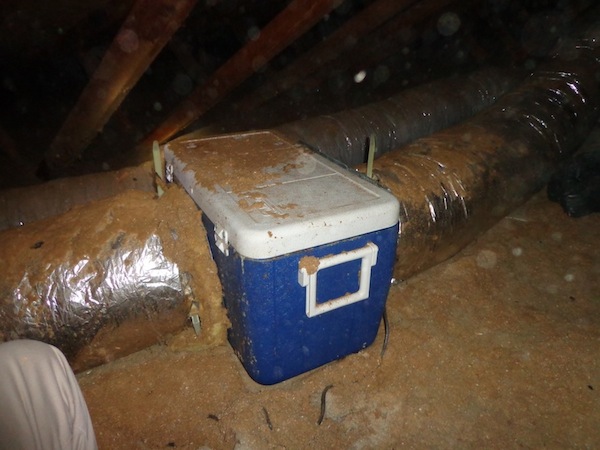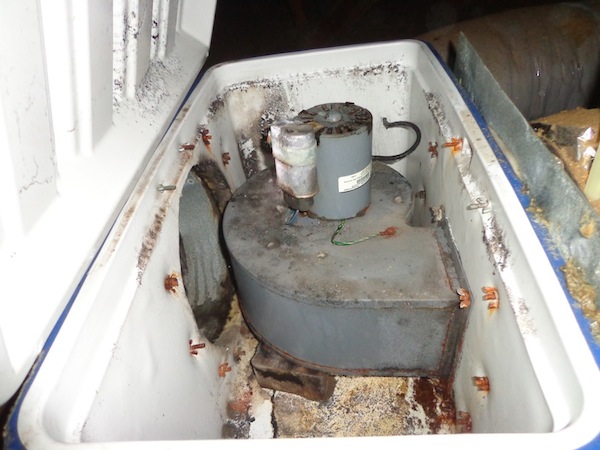What’s That Ice Chest Doing in This Attic Duct System?

Sometimes you see something in a house that splits your head open, revealing the little green pistachio head that sees the world in a completely different way. I love those moments! It’s Stumpy, the duct amputee, which I saw back in ’09, or the Kraken ductopus of Snellville from ’07. These things make you stop in your tracks and realize that when given infinite possibilities, someone out there is going to see how many they can try, no matter their effectiveness. One of those people is responsible for this ice chest duct system.
I posted this photo on our Facebook page last December with the question, What do you think is in that cooler? It got more organic views than anything else I’ve posted, over 12,000 in just a few days. And it’s no wonder. You look at that ice chest and you just have to applaud the creativity of the person who thought of it.
Of course, that’s all you should applaud here because when you use non-standard, unapproved materials in a duct system, you usually get problems you may not have anticipated. As many people suspected when they saw the photo on Facebook, what’s inside the ice chest is a booster fan, as you can see below. The purpose was to get more air to room(s) downstream of that duct.

What’s wrong with that?
The first problem is that when you put in a booster fan that big, you’re likely to scramble the air flow in the rest of the duct system, which is what I understand happened here.
Growing mold in there is another problem. Eric Aune of Mechanical Hub was the first to respond to my Facebook question, saying mold was in the cooler. I don’t know what the dynamics were that led to the mold growth, but it almost certainly was related to the fact that this part of the duct system wasn’t sealed well. Notice the mold around the top edge.
If you have problems with some rooms not heating or cooling properly, a duct retrofit may be a good solution. Many times, though, the problem is with the building enclosure. You’ve got air leaks or poorly installed or missing insulation that need to be fixed.
The photos above look like a DIY job to me. I don’t know for sure, but I was told by the person who sent me the photo that the ice chest booster fan caused more problems than it solved. When it comes to home performance, it’s often possible to be too clever.
Related Articles
Little Shop of Duct Design Horrors
The Case of the Duct That Wasn’t There
Perhaps the Worst HVAC Duct Idea Ever — The Panned Joist Return
This Post Has 7 Comments
Comments are closed.

Creative, but for nothing.
Creative, but for nothing.
In the past I’ve wondered about the actual physics that set up inside a duct when a “booster fan” is also in the duct. On basic terms, how I understand it, if the blower inside the duct is able to move more CFM than is being supplied to it, the section of duct leading up to the blower will be negative in respect to the discharge side of the blower. Meaning this blower has to try and get what air it can from the only source supplying it: the supply plenum at the AHU. Meaning…it could theoretically “rob” air from other ducts also connected to this plenum?
What I do know with confidence is that the average “booster” fan is a restriction in a run of duct, even with the blower running. And…the typical way most must ingest air and then discharge it creates a turbulent zone at the blower location, so it ends up being a net loss if the end goal is to increase airflow to a problematic zone in a building.
Some people will swear by these things…perhaps in certain configurations it actually accomplishes something, but in my experience it mostly goes the other way.
Cameron wrote: (booster fan)
Cameron wrote: (booster fan) “…could theoretically “rob” air from other ducts also connected to this plenum?”
That’s exactly what you want it to do… change the static pressure in the system in order to rebalance the airflow — sending more to an area that’s under-served and less to areas that are over-served.
The only way an inline fan won’t increase flow in a branch or trunk is if it’s turned off, in which case it will reduce airflow compared to no fan.
Whether or not an inline fan creates turbulence at the blower depends on how far away it’s located. It would have to be very close. Turbulence in the duct, away from takeoffs, isn’t an issue worth worrying about. That only affects the inline fan efficiency.
Inline fans are usually applied in retrofit situations to solve a balance problem, although I have specified them in new construction on two occasions. Like anything else, proper design and installation is important. No coolers for me!
It will only get worse. It’s
It will only get worse. It’s a shame that we see this in our industry. Until we have enforcement of codes and mandatory training each year and mandatory licensing for technicians, as well as, contractors then this is what we will keep seeing. It is a travesty when we have up to 80% of the units in our industry installed improperly. Thanks for sharing and writing your blog.
I don’t know of any data that
I don’t know of any data that has ever demonstrated that licensed technicians or contractors do better work than unlicensed ones, or that codes and permits ensure better performance.
Training is wonderful if you can get the technicians in the seat, but that doesn’t happen. The boss or the secretary attends the training to certify the company, while the workers that build America continue on.
As more consumers demand measured performance and are willing to pay for it, we will find smart bosses willing to invest in see technicians sitting in training seats, and the real change will happen.
Allison’s blog is so great for showing consumers exactly what they need to be asking for (and making sure they get!)
“I don’t know of any
“I don’t know of any data that has ever demonstrated that licensed technicians or contractors do better work than unlicensed ones, or that codes and permits ensure better performance.”
It’s all about generating money for the local government. It’s about as effective as gun control laws for criminals. Hackers gonna hack, regardless of what the licensing requirements are.
Maybe so but something is
Maybe so but something is broken when such a high percentage of our installations are inadequate. I see it here in a big way. It ought to be a law against what’s happening in the Memphis area. A 10 year old could do a better job.
Laws are only as good as they
Laws are only as good as they are enforced. When homeowners/builders hire the lowest bidder they get what they pay for. Educating homeowners on the benefits of hiring better contractors would be more effective than passing yet another law that’s unlikely to be enforced.